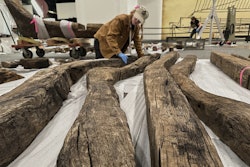
 Allison Grealis and I met briefly at the 4th annual Women in Manufacturing Summit, where women working in manufacturing came from around the country to network, share experiences, and offer advice to young women thinking about entering the field.
Allison Grealis and I met briefly at the 4th annual Women in Manufacturing Summit, where women working in manufacturing came from around the country to network, share experiences, and offer advice to young women thinking about entering the field.
Ms. Grealis is the founder and executive director of Women in Manufacturing, and she also serves as the Vice President of Membership and Association Services for the Precision Metalforming Association. Since Women in Manufacturing began in 2009 it has expanded to represent 500 members from a diverse array of manufacturing industries.
The Summit featured speakers on a variety of issues relevant to women in the manufacturing field, but the event's speakers all echoed WiM's goal in one way or another: to attract, support, retain, and advance women in manufacturing. I wrote on the topic and my experiences at the Summit in my blog "The Skills Gap And Why We Need A Modern Rosie," but I'm no expert, so I caught back up with Ms. Grealis. We chatted about under-representation of women, why this under-representation occurs, and what companies can do to balance out their workforce.
--
Bridget Bergin: How did you originally become interested in pursuing a career in manufacturing, and how did your experiences in the industry lead to you serving as executive director of Women in Manufacturing?
Allison Grealis: While I did not seek an education in a STEM-related profession, I grew up in a manufacturing-related household that has greatly influenced my current passion for the industry and the field. My father has spent the bulk of his professional career in the tire manufacturing and retail industry, which led to our move from Rochester, NY to the rubber capital of the world of Akron, OH in the 1980s. I recall fondly spending many holiday breaks and summers accompanying him to work and getting exposed first-hand to the shops that he managed and the talented and diverse folks that made up his workforce. The skilled trades and hard work I witnessed were eye-opening and a great reminder to me as I returned to school.
My education in English, women’s studies, and public administration has poised me to passionately and intelligibly lead our organization and advocate for our community’s interests. I feel like my career has come full circle, and I feel blessed to have the opportunity to put to work my community organizing and public administration skill sets as I represent the interests of women in an industry in which they are presently underrepresented. I love what I do and especially the populations of professionals, students, and innovative companies I get to represent.
I joined the Precision Metalforming Association (PMA), a full-service trade association representing the metalforming industry, in 2001 and since then, I have held a variety of positions that included district, committee, and division management; affinity partner relations; sponsorship sales; new product and service development; and member services. Currently, I split my time between serving as vice president of membership and association services for PMA and executive director of Women in Manufacturing (WiM).
BB: Women in Manufacturing's blog post about the STEP Awards mentions the relationship between the skills gap in manufacturing and the under-representation of women in the industry. Could you speak more to that relationship?
AG: There are many high-tech and highly paid positions available in the U.S. manufacturing sector today. As the manufacturing sector continues to grow, employers are looking to hire workers with the right skills. Some estimates say that there are as many as 600,000 skilled manufacturing jobs open right now. But too often, employers are unable to find candidates with the skills they need.
The skills gap – the gap between the number of skilled jobs available and the number of workers in the market with those skills – is a problem that cannot and should not be solved by looking at only one-half of the population. Right now, women make up approximately 50% of the U.S. labor force overall, but only about 24% in the manufacturing labor force. At WiM, we’re trying to bring more women to manufacturing because we know that manufacturing is good for women and women are good for manufacturing, too.
BB: Why are women less likely than men to pursue careers in manufacturing, and how does Women in Manufacturing's mission account for these challenges?
AG: Good question. WiM wanted to know the same thing so we did some research. In August of 2014, we co-sponsored a survey with Plante Moran as part of our efforts to attract, retain, and advance women in the manufacturing sector. The results showed that there is an overlap between what young women want in careers and the opportunities available in manufacturing. See, young women report that they want high paying jobs that offer interesting and challenging work. At the same time, women who are in manufacturing today score the sector high for offering good compensation and compelling work.
But, at the same time, the survey results show that young women do not know about the opportunities in manufacturing. There is a gap between what young women report that they want in their careers and what they believe about manufacturing. For instance, only a small number of young women in the survey selected manufacturing among the top five career fields that they feel offer the most opportunity for young women. Looking deeper, we can see that this gap is largely a perception problem. When asked what comes to mind when considering a career in manufacturing, young women often reported phrases like “male-dominated” or “factory/warehouse.”
At WiM, we know that modern manufacturing offers clean, high-tech, and lucrative opportunities well suited for men and women workers. And our research is an important step toward knowing what stereotypes and stigmas are keeping women away and what strategies might help the sector appeal to women workers.
BB: In what employee roles and in what sectors of the manufacturing industry do we see the most gender disparity, and why do you think that is? What can companies in these areas do to improve how they recruit and retain female employees in these roles?
AG: It has been widely reported that the number of women in manufacturing is decreasing. A segment of the research produced on this trend has indicated that one of the big reasons for these declining numbers is the increase in automation, said to be eliminating some of the manufacturing sector jobs traditionally held by women. But it's important to remember that advances in automation have also created great opportunities for women in manufacturing. The addition of automation and technology means that today's manufacturing is much more about brains than brawn. This is a message that is vitally important to spread to women.
Companies can capitalize on this opportunity by investing in women. For example, WiM has a number of corporate sponsors who support our programming and events. These partnerships are especially valuable in promoting women in the sector. So much of our work at WiM, from helping women in the industry share their success stories to helping to foster mentoring relationships, is centered around dispelling negative stereotypes and demonstrating that manufacturing is a great sector for women.
BB: The manufacturing sector seems to be undergoing a technology revolution. What is the relationship between the current climate of manufacturing, STEM initiatives, and other educational and training initiatives geared toward women?
AG: I’ve already addressed the technological revolution in manufacturing so I’ll focus on the educational landscape right now, which is interesting. Women are receiving more diplomas than men - female graduates hold some 60 percent of all bachelor’s degrees. But, women are being far outpaced in most STEM fields. In recent years, statistics show that only one in seven engineers is a woman and less than 20 percent of bachelor’s degrees in computer science go to women.
But the root of the problem actually begins much earlier than the workforce. Studies have found that young girls may have high math and science test scores, but they still steer clear of careers that require those same skills. This tendency is often attributed to persistent, negative stereotypes about STEM education and STEM fields that keep women away.
At WiM, we are doing our part to eliminate those intimidation factors and encourage girls and women of all ages to pursue STEM. Building a solid infrastructure of a supportive community is important because we often hear from our members that they were not planning on a career in manufacturing until someone along the way recognized their talent and encouraged them.
One great thing about manufacturing is that it is never too late to get involved in training programs. There are many educational opportunities available for people from all backgrounds to get the skills needed for a successful career in manufacturing today.
--
The underrepresentation of women in STEM and manufacturing fields is an undeniably hot topic right now. In the last two days alone, NPR has featured two stories on getting women more interested in computer sciences: "When Women Stopped Coding" and "To Get Women To Work In Computer Science, Schools Get Them To Class." In September, U.S. News & World Report ran a story entitled "The Lack of Women in STEM Is a National Security Issue," last October The New York Times ran "Why Are There Still So Few Women in Science?", and Forbes has an entire section called Forbes Women that features numerous related articles. Ms. Grealis' insight sheds light on this topic from a manufacturing perspective. For more information on Women in Manufacturing, visit their website.























